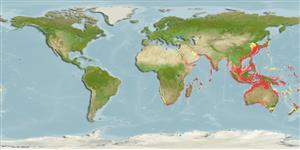Environment: milieu / climate zone / depth range / distribution range
Ecología
marino demersal; rango de profundidad 10 - 200 m (Ref. 121768). Tropical; 36°N - 34°S, 24°E - 154°E
Indo-West Pacific: Algoa Bay, South Africa to southern Japan and Australia.
Length at first maturity / Tamaño / Peso / Age
Maturity: Lm 30.0 range ? - ? cm
Max length : 90.0 cm SL macho / no sexado; (Ref. 559)
Short description
Claves de identificación | Morfología | Morfometría
Espinas dorsales (total) : 0; Radios blandos dorsales (total) : 12 - 14; Espinas anales: 0; Radios blandos anales: 10 - 12. Dorsal part of body without prickles, belly covered with prickles (Ref. 559). Greenish or dark grey above, silvery white below (Ref. 4919). Distinguished from other Lagocephalus species by the black gill opening (Ref. 559).
Found in the shelf edge (Ref. 11230). Closely resembles the Atlantic species L. laevigatus Linnaeus which reaches southern Angola (Ref. 4919).
Life cycle and mating behavior
Madurez | Reproducción | Puesta | Huevos | Fecundidad | Larva
Smith, M.M. and P.C. Heemstra, 1986. Tetraodontidae. p. 894-903. In M.M. Smith and P.C. Heemstra (eds.) Smiths' sea fishes. Springer-Verlag, Berlin. (Ref. 4919)
IUCN Red List Status (Ref. 130435: Version 2024-2)
Threat to humans
Poisonous to eat (Ref. 559)
Human uses
Herramientas
Special reports
Download XML
Fuentes de Internet
Estimates based on models
Preferred temperature (Ref.
123201): 16.6 - 28.3, mean 26.4 °C (based on 1313 cells).
Phylogenetic diversity index (Ref.
82804): PD
50 = 0.5005 [Uniqueness, from 0.5 = low to 2.0 = high].
Bayesian length-weight: a=0.02692 (0.01731 - 0.04185), b=2.86 (2.73 - 2.99), in cm total length, based on LWR estimates for this species & Genus-body shape (Ref.
93245).
Nivel trófico (Ref.
69278): 3.9 ±0.4 se; based on size and trophs of closest relatives
Generation time: 2.1 ( na - na) years. Estimated as median ln(3)/K based on 1
growth studies.
Resiliencia (Ref.
120179): Bajo, población duplicada en un tiempo mínimo de 4.5-14 años (K=0.53).
Fishing Vulnerability (Ref.
59153): Moderate vulnerability (36 of 100).
